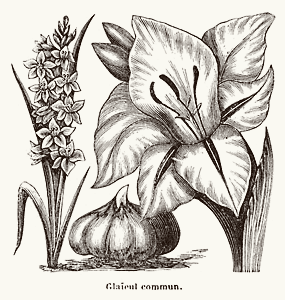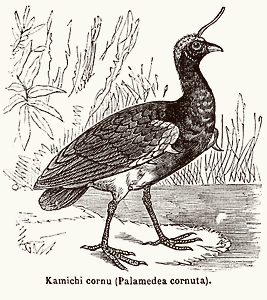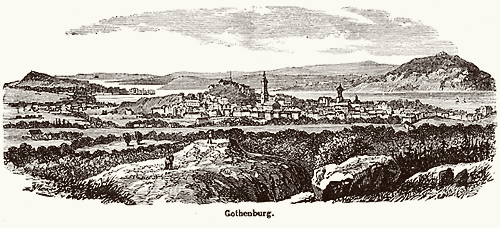
GLADIOLUS s. (lat. gladius, sword, because its leaves are long, narrow and pointed). Bot. genus of the iridaceae family which includes a great number of species and hybrids sought for the size, the form and the beauty of their flowers. – The cornflag (gladiolus communis) bears beautiful pink flowers. The most beautiful exotic species are: gladiolus cardinalis, with large flowers of a very bright scarlet colour; gladiolus versicolor, with …Read more »
Tags: flowers, iridaceae, plants, Trousset encyclopedia

HORNED SCREAMER s. Large black bird of the wader order, palamedeae family, whose head is adorned with a sort of helmet and whose wings are armed with spurs: it lives in the marshes of Guyana and Brazil. The horned screamer (palamedea cornuta, Linn.), is larger than a goose, it is approximately 130 cm (4′ 4″) long; it is blackish with a red spot on each shoulder, the lower parts of the chest are white. Horned Screamers usually live …Read more »
Tags: animals, birds, Brazil, Guyana, ornithology, Trousset encyclopedia, wader

KANGAR00 s. Mamm. Kind of marsupial, which includes several species of quadrupeds living in Australia and the nearby islands, remarkable by the volume of their tail, which they use for leaping, and by the amazing length of their lower limbs. Kangaroos feed on plants, grazing like ruminants and like them, according to Owen, they sometimes chew twice the food contained in their first stomach; they vary in height, from that of a man to that of a hare; when grazing, they put their forefeet on the ground, but otherwise they rest on the tripod formed by their hindlegs and their tail, with the upper part of the body slightly bent forward. They are the only marsupials not to be nocturnal. The largest and best known species is the large kanguroo (macropus giganteus, Shaw), discovered in 1770 on the coast of New South Wales during Cook’s first travel; an adult male owned by the British museum, measures 175 cm (5’9″) from the tip of the nose to the root of the tail; the latter being 4’3″ long; the female kangaroo is …Read more »
Tags: animals, Australia, mammals, marsupials, Trousset encyclopedia

GOTHENBURG or Gottenburg ( swed. Goeteborg) — 1, lœn or province of the S.-W. of Sweden, bounded by the Kattegat, the Skager-Rack and Norway; pop. 244.010. Gothenburg forms a narrow stip of land between the mountains which separate it from Elfsborg in the E. and the coast. Harsh climate; barren ground.
— 2, capital of this province, on the Kattegat, at the mouth of the river Göta älv, 320 kil. W. – S. – W. from Stockholm; pop. 65.000. It has a good port and a canal network. Large factories. Most merchants are scottish or English.
Extract from the Trousset encyclopedia, 1886 – 1891.
Tags: city, Europe, geography, landscapes, Sweden, Trousset encyclopedia

GILLYFLOWER(1) s. Bot. herbaceous plant in the cruciferae family, which includes about fifteen species. Some of them are cultivated in gardens, because of the scent and beauty of their flowers: a bunch of gillyflower.
– Also applies to the flowers of …Read more »
Tags: flowers, plants, stock, Trousset encyclopedia

CHEETAH. Mamm. type of carnivore of the large family of cats. The cheetah (felis jubata, Schreb;), also called hunting leopard or maned leopard, lives in Southern Asia and Africa. It looks like an enormous cat; but it is …Read more »
Tags: animals, cats, mammals, Trousset encyclopedia

P0LARISC0PE S. (from polarization; gr. skopeô, I examine). Phys. Device which allows the polarization phenomenon to be perceived, when occuring with a low intensity. The polariscope shown in our figure is made of a wooden base, on which a square glass plate (ab), whose bottom was painted in black, is placed; this is the polarizer. Two stands made of wood (cd) are fixed on each side of this glass plate at an angle …Read more »
Tags: analysis, device, gemology, instrument, optical, polarization, science and technology, technology, Trousset encyclopedia









